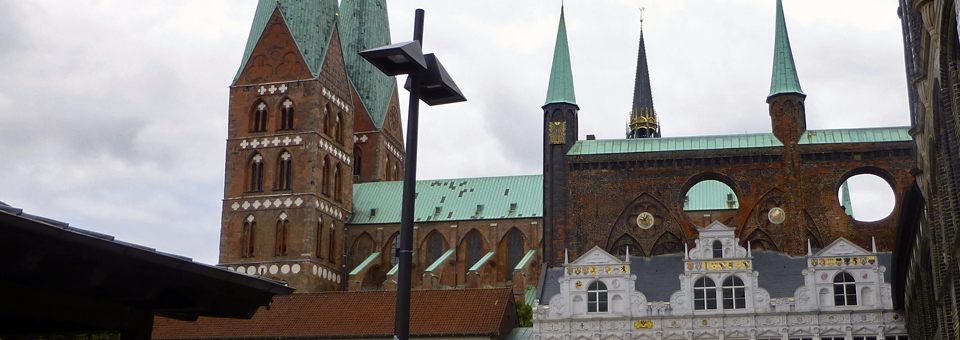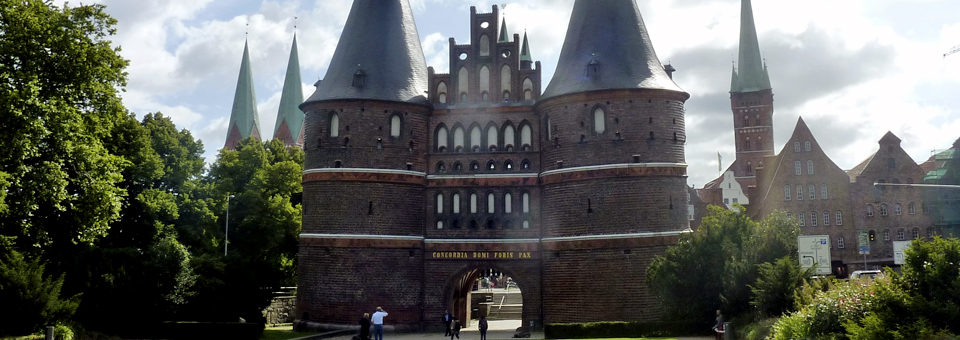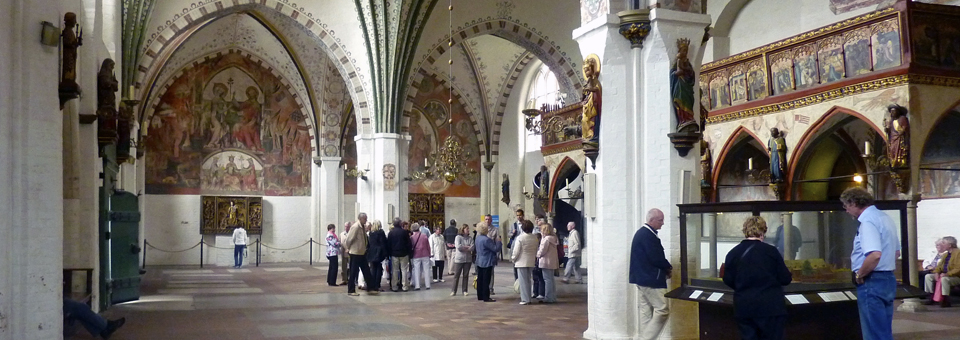Lübeck, Germany
“This is Lübeck–where you find surprising places.” our guide, Jan Kruijswijk, told us as we walked along a winding alley and peeked through one of Lübeck’s 90 or so little arches and passageways.
The alleyways led to smaller houses 15th and 16th century merchants built behind their own homes and rented them to laborers, craftsmen, or serfs fleeing repression elsewhere. Serfs who evaded capture for a year and a day became free here. These homes, now renovated and upgraded, are treasured properties.
Lübeck was founded in 1143 as the first Western city on the Baltic coast. By 1226, a time when feudalism and local lords ruled, Frederick II, Emperor of the Holy Roman Empire, granted Lübeck the status of Free City of the Empire, making it accountable only to the Emperor.
The 7-spired Old Town, Alstadt, is on an island enclosed by the Trave River, and was the prosperous, powerful, and centrally-located leader of the Hanseatic League. With the cog, a rugged trading vessel that could carry 100 tons of goods, and access to Baltic herring supplies and “white gold” (salt) to preserve it, trade expanded as far as Russia, Venice, and the Orient.
Wealthy and powerful merchants ruled here. Their 335’ tall church, St. Mary’s, is in the city center and higher and grander than the Cathedral. It is the largest brick Gothic church in the world and renowned for its organ concerts. Traditionally, only the Cathedral had two towers. However, when the bishop ran out of money, the wealthy merchants provided funding in exchange for the same privilege for their church.
Composer Dieterich Buxtehude was the organist of St. Mary’s from 1667 to1707. He invited Johann Sebastian Bach to succeed him on the condition Bach marry his eldest daughter. Bach declined.
By the 14th century Lübeck was Queen of the Hanseatic League. In 1375 it was named one of the five “Glories of the Empire” by Emperor Charles IV, along with Florence, Pisa, Rome, and Venice.
Lübeck and the Hanseatic League survived conflicts with Denmark and Norway, piracy, and plague. It remained neutral in the Thirty Years War, but the devastation in Europe and growth of the emerging transatlantic market shifted the center of trade and led to its disbanding.
The league met for the last time in Lübeck in 1669.
Hitler had contempt for Lübeck for not allowing him to campaign there. His Greater Hamburg Law incorporated Lübeck into Schleswig-Holstein, ending its independence. On March 28, 1942, Lübeck was the first German city to be attacked by Allied bombing. After the war it became part of West Germany.
Today Lübeck is the largest German port on Baltic Sea and a UNESCO World Heritage Site. Two of the original four gates remain–Burgtor (1444) and Holstentor (1478), the tippy-towered, best-known symbol of the city.
It is said that marzipan was first made in Lübeck when the town ran out of all food except almonds and sugar. A visit to its best-known producer, Niederegger, is a must. We shopped for this delectable treat in a variety of shapes, including fruit, sailors, and the classic pig. Tempted by the artful array of pastries, we headed upstairs to the marzipan museum and to enjoy coffee and marzipan cake in the café while overlooking the Town Hall where Hanseatic meetings were held.
Lübecker Marzipan is often paired with another local specialty, Rotspon, a red (rot) wine named for the “spon” or wood chip of the barrels in Hanseatic times. Napoleon’s soldiers were among those who noted that this Bordeaux wine tasted better when aged in Lübeck.
We were able to go inside some of the merchants’ houses that now belong to the University of Lübeck. Goods came in on the ground floor and were hoisted up the center for privacy. The family lived above, on the grand “Belle Etage”.
We saw the little cabins inside the medieval Holy Ghost Hospital, one of Europe’s oldest social institutions. It was built by rich merchants for elderly people who had no one to care for them. They were given a warm meal every day and 3 liters of beer–the beverage of choice since water was not safe to drink. In return, the residents prayed for the merchants five times a day. It is now a retirement home and its annual Craftsmen’s Christmas Market draws international visitors.
We stopped at the impressive gabled Buddenbrook House, a museum and former home of literary brothers Thomas and Heinrich Mann’s grandparents.
It is named after one of Nobel laureate Thomas’ books.
We had a late lunch at the Schiffergesellschaft zu Lübeck, the House of the Seamen’s Guildhall, acquired by the Brotherhood of Captains in 1535. With its stepped brick gable, gilded weathervane and rococo door, it is one of the most notable medieval buildings in Lübeck.
We sat in the historic banquet hall on the skippers’ original benches and dined on classic specialties as we gazed at centuries-old artifacts and suspended ship models that dated as far back as 1607.
Lübeck is inland along the river, and in Medieval times the nearby coastal settlement Travemünde provided harbor entry and protection against invaders.
Travemünde is now a seaside resort and the largest Baltic ferry port in Germany, connecting to Estonia, Finland, Latvia, Russia, and Sweden. There’a a ship museum and annual events that include a sailing race week and sand festival. Thomas Mann wrote about Travemünde in Buddenbrooks, his book about four generations of a German merchant family. We’re reading the English translation now and dreaming of our next visit.
A few tips
If you plan to travel to several places within Germany, look into the savings and convenience of a Rail Europe German Rail Pass . It provides unlimited travel on Germany’s national rail network. Options include 3, 4, 5, 6, 7 or 10 days within 1 month, consecutively or not.
Here are just a few special events:
Savor glühwein and smoked sausages at Rostock’s Christmas market, the largest in Northern Europe.
In June, about 2000 yachtspeople from around the world compete in nearby Warnemünde. Travemünde Week, in July, is one of the world’s best sailing events.
In August, about 200 fully rigged saling ships participate in nearby Rostock’s renowned Hanse Sail.
The 34th Annual International Hanseatic Days is generally held in May.











